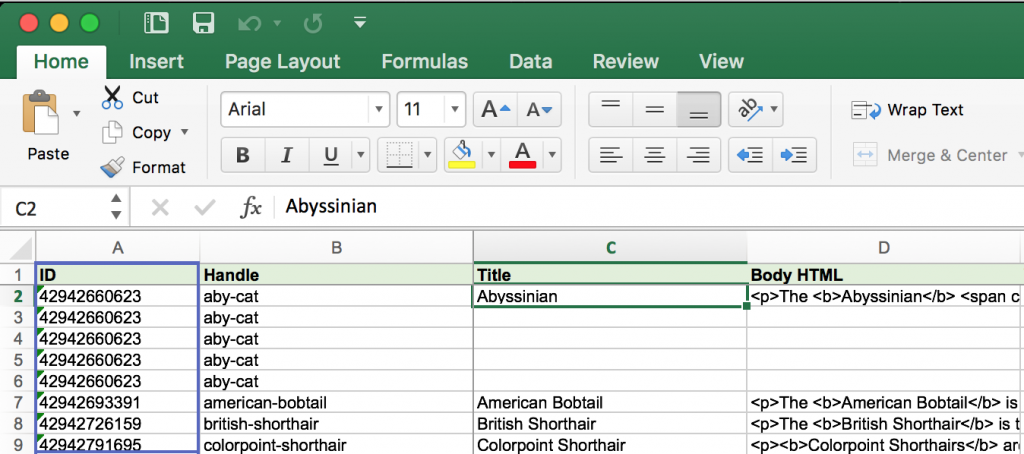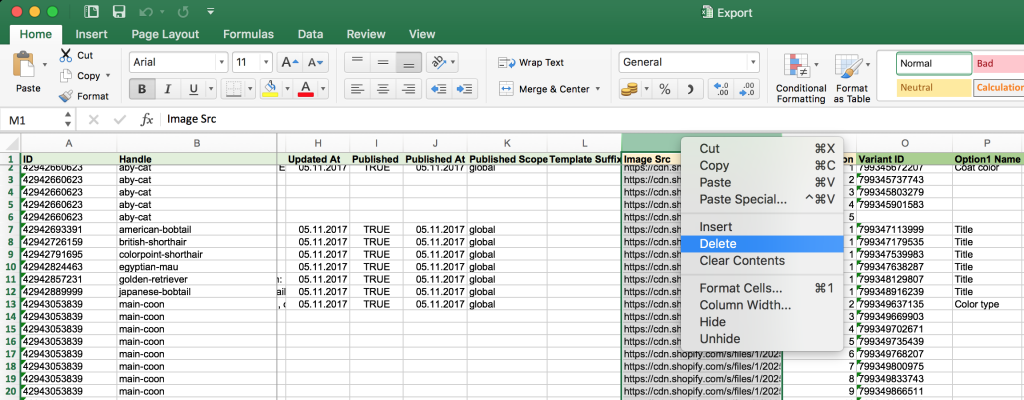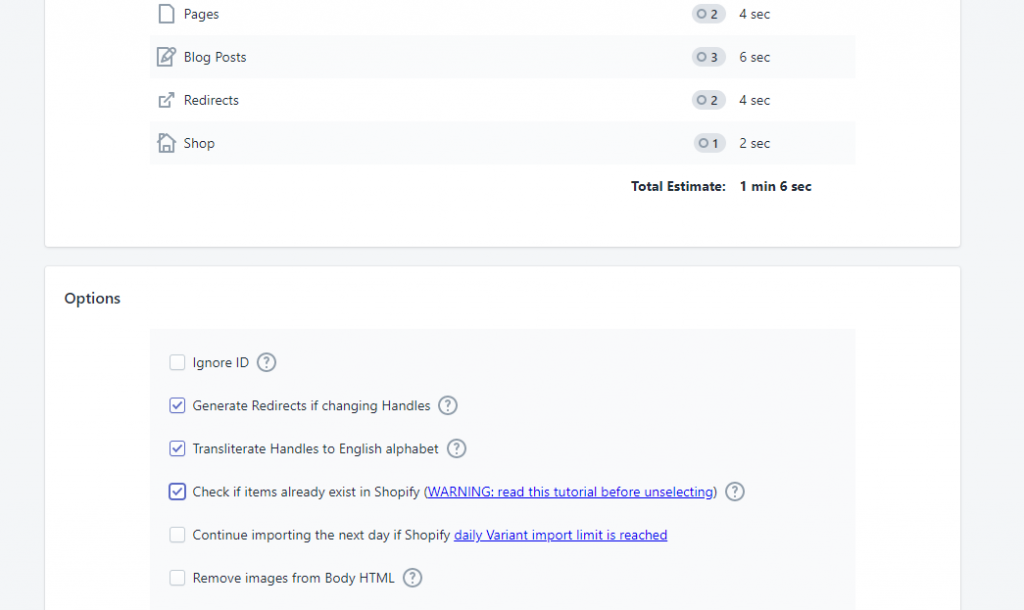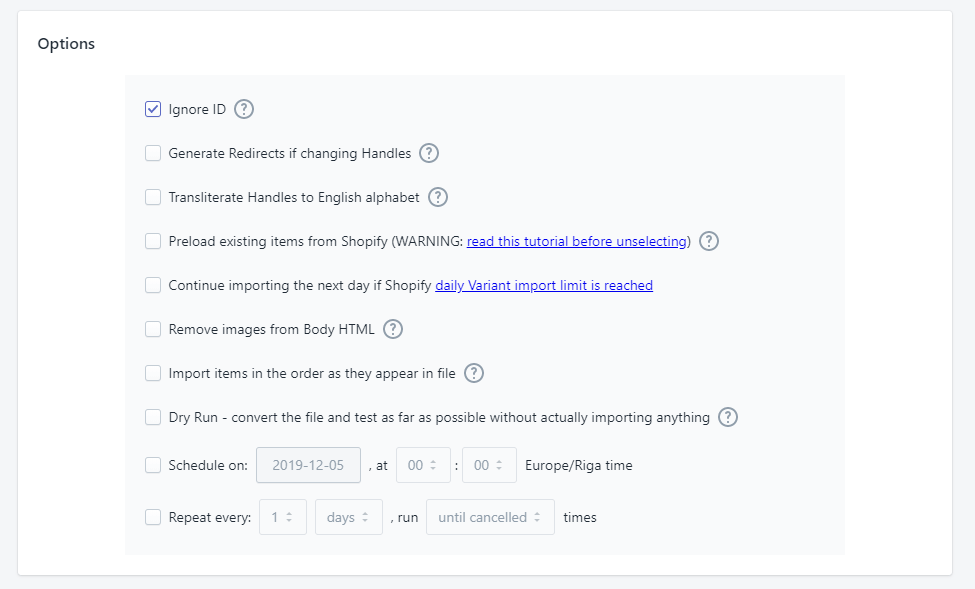Faster Way to Upload Products to Shopify

The simplest way to improve speed – upgrade!
If yous just want the maximum speed, you tin can upgrade your plan to Big Plan or even Enterprise Plan.
Big Program has the v threads importing data in parallel.
Enterprise Program has 10 (or more)threads importing data in parallel.
Athread is an independent process that works with a piece of your import/export data. Several threads tin piece of work in parallel – each with different items.
That gives a meaning boost on the speed.
Just at that place are Shopify API speed limits which tin be improved even further – by organizing import data in a way to minimize requests needed to the Shopify API.
Read more than nearly how Shopify API Phone call Limit works and options to increase it for the Matrixify app in your shop.
Overall import logic
A bit of background logic, how importing to Shopify happens.
At first, an particular is identified past "ID" cavalcade value. ID is the Shopify internal identifier for an item. Yous tin't assign them past yourself – you lot can only become them out past exporting existing items.
If the ID column value is empty or such ID doesn't be – then it tries to observe the existing particular by "Handle" value. In Discounts case the handle is the "Lawmaking" column value; in Customers case that is an "E-mail", but for the sake of common terminology – the app will refer to them as "Handle" in all those cases.
If it finds an existing particular past ID or by Handle, then it will update that item past changing merely fields you provided in the import, and leaves other fields every bit they were. If it will not notice such item, then it will create New.
So if you lot really desire the fastest possible import speed, here'southward what you do in each scenario.
Fastest import of New items
Continue the ID column empty, or remove information technology entirely from the import file.
Then information technology will not even try to detect existing by ID, it will only check if an item with such Handle exists – that is needed to determine if it needs to create New or practise the Update of existing.
If your store is relatively pocket-sized, import speed by Handle volition exist the same as by ID.
Fastest Update of existing items
Beginning – aid the app to identify existing items apace

Take the ID column with ID values from the consign file.
If y'all have an ID for each item, and if the detail with such ID really exists, and then information technology will exist the fastest style to update them – it will do one single "push", and that'south it.
You lot don't have to have an ID – you can have just the Handle. Then it will discover by Handle – information technology volition be roughly two times slower, but still ok.
You lot will accept the slowest speed if you have IDs which don't exist. Considering Then it will try to update by ID, which it volition not find, then it will need to search by Handle, and and so exercise the update. So it volition be three times slower.
Then – whenever yous tin, update by ID, the correct one.
2d – import only fields y'all need to update

When you import your data, whatsoever item columns you import, all of them be sent to Shopify. So to improve the speed, import only those columns, which you actually need to update, and avert importing columns, which yous are sure, are already correct.
The especially big deviation is made with uploading images. Every time you import an epitome, Shopify will re-download that prototype. That adds at to the lowest degree ane second to each item import, which might non seem a large bargain, merely it accumulates big time – imagine if you are importing several thousands of items. And then, if you know you take your images already in place, simply remove image columns from the import file.
A similar principle is most "related" details for each particular. For example, practise you demand to update Product Variant data, when you are updating the Production Tags? Probably not. If you need to just update Production Tags, then you merely remove all the Variant columns (and rows), and it volition not have to touch Variants at all, again, gaining a bit of speed per detail. Similarly, if you don't need to update related Products for Manual Collections (Custom Collections), simply remove those columns (and rows) course import file.
The aforementioned also with Metafields.
Pre-loading
In certain cases, the app will "pre-load" existing items from your store, to make the searching existing items faster. That's because pre-loading is 250 times faster than identifying items one by one, so you can imagine the touch it has on overall import speed.
If you showtime the import and it seems like information technology's not doing anything, give it a infinitesimal or 2, because it decided that in total information technology volition be quicker to pre-load your existing items, and then do the update on them.
Check if items already exist in Shopify
Normally, you should leave this on, every bit the default – that is the safest way to import. So remove that checkbox, only if you lot are absolutely sure, what you are doing.
This import option tin can merely exist enabled by contacting Matrixify back up.
If you are absolutely sure that your import is just creating new items, and they don't exist in Shopify, you can forcefulness the app not to load any of the existing items by any of method. Just exist aware that if items do exist, then there might be failed imports, errors, duplicates, or whatever other unexpected updates or errors if those items exist.
For the app not to cheque if items exist in the shop when importing, remove the checkbox at "Check if items already exist in Shopify".
Also, you tin can speed the import up by not checking if items already be if yous accept the "ID" values. But then, if you are updating too Variants, you need to have "Variant ID" and you need to make certain all of the variants of each product are listed in the file. That will allow it to "Push past ID" without checking if such items already exist. If you will non have all the variants listed for some products, in this case, you will end upwards with just the variants which you lot had in your import for those products. Be actually careful with this kind of import.

Usually, yous should leave this on, every bit the default – that is the safest fashion to import. So remove that checkbox, only if you are absolutely sure, what you lot are doing.
Fastest import when copying from another store
When you lot copy your data to another store, those IDs don't exist in the new shop, so that causes the app to make an additional request to API to find that out. You can improve the speed by checking the "Ignore ID" box in the Import Options. That will tell the app non to try to use those IDs.

Which scenario was called?
You tin can come across, how the existing item was identified, when you await in the Import Results Excel file (which you can download after the import has finished).
In the "Import Comment" column you volition see the post-obit comments (in the order starting from fastest):
| UPDATE: Pushed by ID | If you lot see this, it means y'all did the best job in helping the app to identify the existing detail. |
| UPDATE: Constitute by ID (pre-loaded) | Here the app searched for the existing item by ID in the pre-loaded items list, because it can't push it, information technology needs additional data about the item to be able to do the update. You can improve this by removing columns, which you don't need to update. |
| UPDATE: Found by ID | The aforementioned reason as for pre-loaded, merely app decided that in this case searching items one by 1 is faster than pre-loading all existing. |
| UPDATE: Found past Handle (pre-loaded) | Either y'all don't accept the ID, or the item with such ID doesn't exist in this shop. But it exists with the aforementioned Handle (or Code in instance of Discounts, or Email in case of Customers). Also, app decided that pre-loading items will be the fastest fashion to find them. |
| Found by Handle | The same reason as for pre-loaded, just app decided that in this example searching items one past one is faster than pre-loading all existing. |
| Found past SKU (pre-loaded) | For Products, when Product is being identified by Variant SKU – it volition always exist pre-loaded, because the app volition essentially load all the store into retention, to know, which SKU belongs to which Product. |
| NEW | The new item was created – pregnant, that it didn't observe whatsoever existing item past ID or past Handle. |
Summary import speed tips
- Identify items past correct ID.
- Remove columns and rows form import file which you don't need to update.
What to practice next?
- Review the "How it works?" tutorial.
- Install the "Majority Import Export Update with Excel" app if you haven't already.
- Upgrade to Big Plan or Enterprise Plan to give yourself to bask all the other benefits that come up with them.
Source: https://matrixify.app/tutorials/maximize-shopify-bulk-import-speed/
0 Response to "Faster Way to Upload Products to Shopify"
Post a Comment